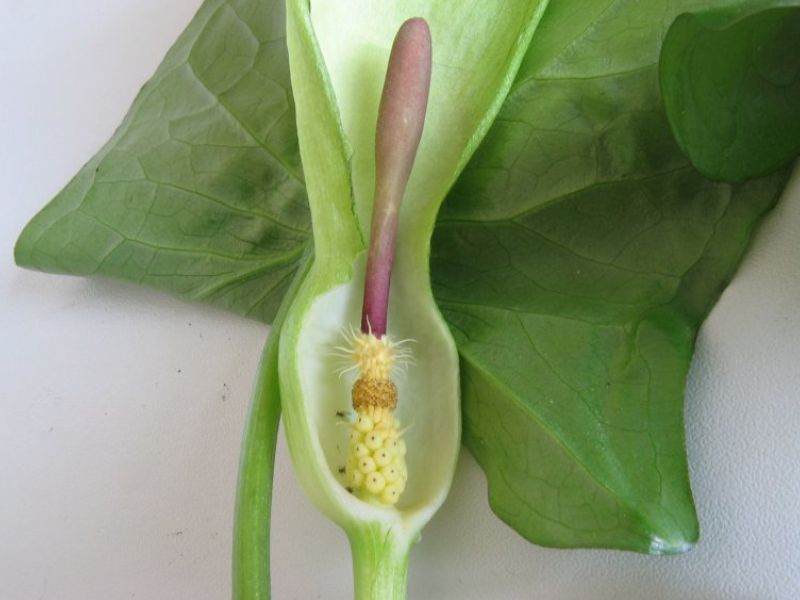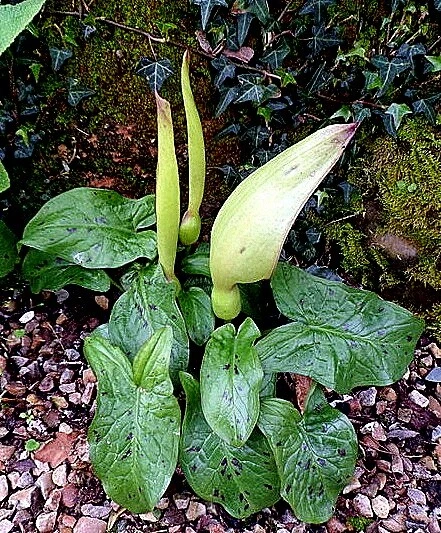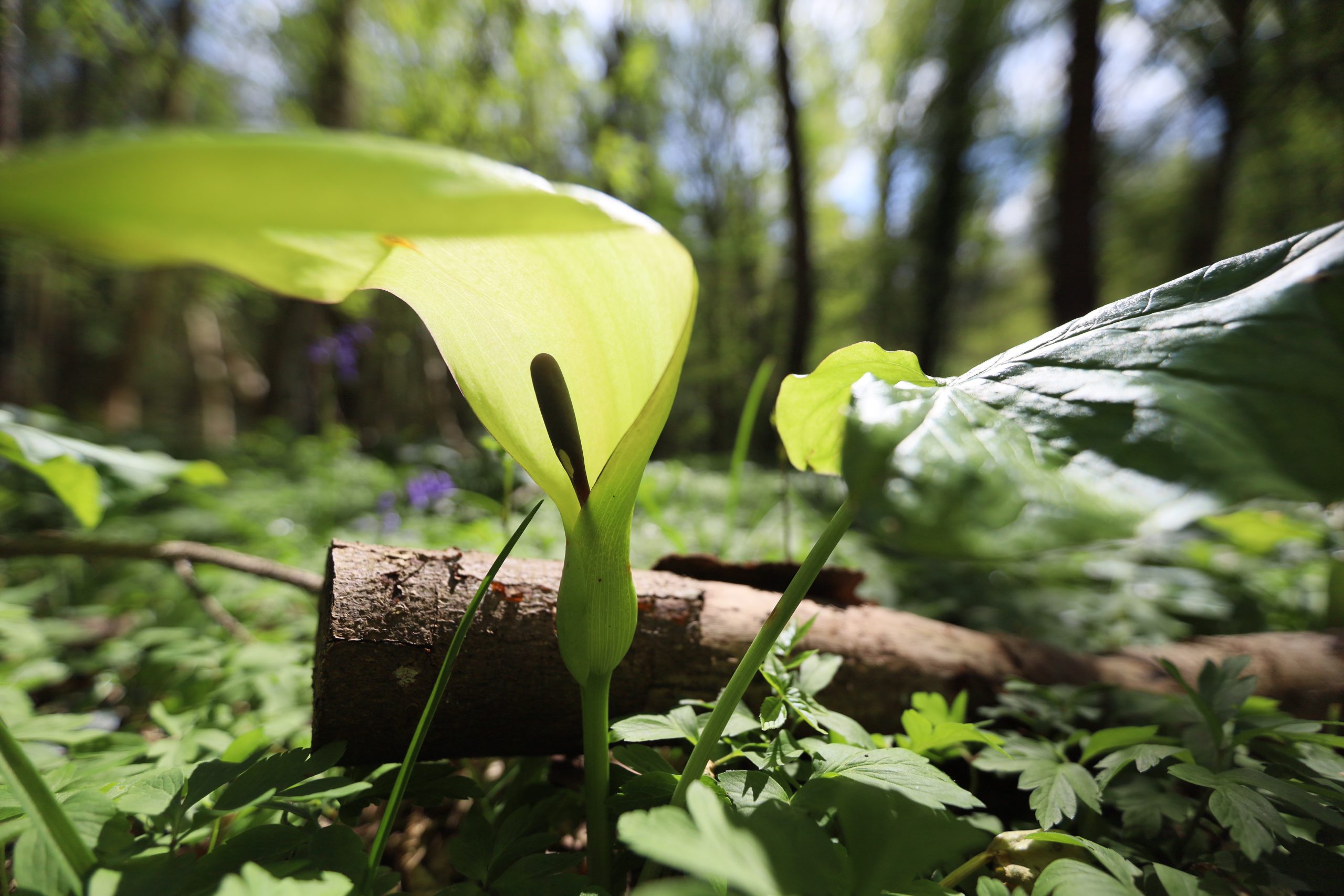Cuckoo Pint, also known by various names like Adam and Eve, Arum Lily, Lords-and-Ladies, and Wild Arum, is a fascinating perennial native to Europe, North Turkey, and the West Caucasus. Belonging to the Araceae family, this plant showcases unique characteristics that make it stand out in any garden.
Growing up to 51 cm tall, Cuckoo Pint produces its flowers in spring, with male and female blooms appearing in yellow or purple shades. Male flowers are equipped with tiny hairs that trap insects attracted by the flower’s scent, ensuring they are dusted with pollen before escaping to pollinate other plants. As summer approaches, the female flowers give way to striking clusters of bright red berries, which, while visually appealing, are highly toxic if ingested.
This plant’s fascinating lifecycle and unusual pollination strategy make it an excellent addition to gardens, offering a touch of mystery and natural allure.
| Common name | Adam and Eve, Arum, Arum Lily, Bobbins, Cuckoo-Pint, Cuckoo Plant, Lords-and-Ladies, Starch Root, Wake Robin, Wild Arum |
| Botanical name | Arum maculatum |
| Family | Araceae |
| Species | maculatum |
| Origin | Europe to North Turkey and West Caucasus |
| Life cycle | Perennial |
| Plant type | Herbaceous Perennial |
| Sunlight | Partial Shade |
| Maintenance | Medium |
| Drainage | Well-Drained |
| Growth rate | Medium |
| Spacing | 12 in. – 3 ft. |
| Harvest time | Fall |
| Flowering period | Spring |
| Height | 1 ft. – 1 ft. 6 in. |
| Flower color | Green |
| Leaf color | Green |
| Fruit color | Orange |
| Fruit benefit | Showy |
| Leaf benefit | Showy |
| Flower benefit | Showy |
| Garden style | Shade Garden |
| Uses | Houseplants |
I. Appearance and Characteristics
Arum maculatum is a woodland flowering plant species in the family Araceae. It is native across most of Europe, as well as Eastern Turkey and the Caucasus.
A. maculatum is known by an abundance of common names including Adam and Eve, adder’s meat, adder’s root, arum, wild arum, arum lily, bobbins, cows and bulls, cuckoo pint , cuckoo-plant, devils and angels, friar’s cowl, jack in the pulpit, lamb-in-a-pulpit, lords-and-ladies, naked boys, snakeshead, starch-root, and wake-robin.
Many names refer to the plant’s appearance; “lords-and-ladies” and many other names may liken the plant to male and female genitalia symbolising copulation. Starch-root is a simple description – the plant’s root was used to make laundry starch and the ‘lords and ladies’ name may alternatively have referred to its use for starching the ruffs worn around the necks of the gentry during the late 16th and early 17th centuries.

The leaves of A. maculatum appear in the spring (April–May in the northern hemisphere, October–November in the southern hemisphere) and are 7 to 20 cm long. These are followed by the flowers borne on a poker-shaped inflorescence called a spadix, which is partially enclosed in a pale green spathe or leaf-like hood.
The spathe can be up to 25 cm high and the fruiting spike which follows later in the season may be up to 5 cm. The flowers are hidden from sight, clustered at the base of the spadix with a ring of female flowers at the bottom and a ring of male flowers above them. The leaves may be either purple-spotted (var. maculatum) or unspotted (var. immaculatum).
Above the male flowers is a ring of hairs forming an insect trap. Insects, especially owl-midges Psychoda phalaenoides, are attracted to the spadix by its faecal odour and a temperature up to 15 °C warmer than the ambient temperature. The insects are trapped beneath the ring of hairs and are dusted with pollen by the male flowers before escaping and carrying the pollen to the spadices of other plants, where they pollinate the female flowers. The spadix may also be yellow, but purple is the more common.
In autumn, the lower ring of (female) flowers forms a cluster of bright red berries up to 5 cm long which remain after the spathe and other leaves have withered away. These attractive red to orange berries are extremely poisonous.

The root-tuber may be very big and is used to store starch. In mature specimens, the tuber may be as much as 400 mm below ground level.
Many small rodents appear to find the spadix particularly attractive; finding examples of the plant with much of the spadix eaten away is common. The spadix produces heat and probably scent as the flowers mature, and this may attract the rodents.
Arum maculatum is also known as cuckoo pint or cuckoo-pint in the British Isles and is named thus in Nicholas Culpeper’s famous 17th-century herbal. This is a name it shares with Arum italicum (Italian lords-and-ladies), the other native British Arum. “Pint” is a shortening of the word “pintle”, meaning penis, derived from the shape of the spadix. The euphemistic shortening has been traced to Turner in 1551.
The plant is propagated by birds dispersing the seeds by eating the berries. As a seedling the plant has small light green leaves that are not glossy like the mature leaves. At about 5 months its leaves grow larger and glossier. At one year old all of the leaves become glossy and die back. The next year the plant flowers during summer.
Toxicity
All parts of the plant can produce allergic reactions in many people and the plant should be handled with care.
The attractive berries are extremely poisonous to many animals, including humans, but harmless to birds, which eat them and propagate the seeds. They contain oxalates of saponins, which have needle-shaped crystals that irritate the skin, mouth, tongue, and throat, and result in swelling of throat, difficulty breathing, burning pain, and upset stomach.

However, their acrid taste, coupled with the almost immediate tingling sensation in the mouth when consumed, means that large amounts are rarely taken and serious harm is unusual. It is one of the most common causes of accidental plant poisoning based on attendance at hospital emergency departments.
There is no known antidote to A. maculatum poisoning. Airway management may reduce the mortality, and aggressive fluid administration may prevent renal injury.
II. How to Grow and Care
Sunlight
Cuckoo pint thrives best under partial sun conditions, with dappled sunlight being ideal to maintain its vibrant growth. It tolerates a broad range of light, from full sun to full shade, though in full sun, growth may be stunted and foliage can scorch, while in deep shade, flowering might be reduced. The plant has adaptations to adjust its leaf orientation to optimize light absorption.
For outdoor growing, cuckoo pint should be planted in a location that mimics its natural understory habitat, usually found under the canopy of deciduous trees where it receives filtered sunlight. Consistent with these conditions, cuckoo pint will flourish, demonstrating robust health and vitality.
Watering
Native to temperate woodlands, cuckoo pint thrives in moist soil conditions that mimic its natural understory environment. This species exhibits a preference for consistent moisture and is moderately drought-tolerant. Regular watering every week maintains its lush growth. As an herbaceous perennial commonly grown outdoors, cuckoo pint’s water needs are particularly influenced by the growing season, with increased demands during active growth phases.

Fertilizing
For cuckoo pint, use balanced nutrition fertilizers, applying a diluted solution every 4-6 weeks during active growth in spring and summer. This sustains robust growth and vibrant spathe production. Less is more—avoid overfertilization to prevent root burn. Tailor to life cycle: reduce in fall, pause in winter dormancy. Wear gloves, as cuckoo pint’s sap can irritate skin. Ensure even distribution around the plant, avoiding direct contact with the foliage. Novices and experts adhere to label instructions for a flourishing cuckoo pint.
III. Uses and Benefits
- Ornamental uses
Cuckoo pint is a flowering perennial that produces bright red and orange berries during the fall. It is valued in woodland and shade gardens for its attractive flowers and colorful berries. Gardeners should take care to control the growth of this species through rhizomes so it does not overtake other species in gardens where it is planted. Cuckoo pint is sometimes planted in informal cottage gardens as well along perennial borders.

- Culinary uses
The root of the cuckoo-pint, when roasted well, is edible and when ground was once traded under the name of Portland sago. It was used like salep (orchid flour) to make saloop, a drink popular before the introduction of tea or coffee. It was also used as a substitute for arrowroot. It can be highly toxic if not prepared correctly.
The leaves, which are toxic, can be mistaken for edible sorrel.
Arum maculatum is also used to make soup in the Andırın region of Turkey where the leaves are leavened with yogurt and boiled for long hours which eliminates toxicity. This process results in a sour soup which is called Tirşik.
- Other uses
The roots were a traditional source of starch for stiffening clothes. In 1440, the nuns of Syon Abbey in England used the roots of the cuckoo-pint flower to make starch for church linens; only starch “made of herbes” could be used for communion linen.
Find Where to Buy the Best Cuckoo-Pint (Arum maculatum)


















Leave a Reply